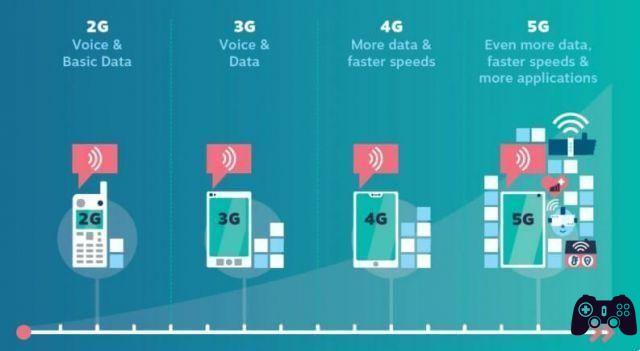There is a lot of talk, sometimes even inappropriately, about 5G, the new generation mobile network It has already landed in some Spanish cities. 5G means 5th Generation, the first antennas compatible with the new standard were installed in 2019.
The pandemic has not stopped expansion plans and new connectivity is becoming more widespread. In the following paragraphs we will illustrate How 5G works, what are its advantages and performance.
5G will represent a true revolution in mobile technology: not only will it be possible to watch high-resolution videos with the same ease with which we listen to music today, but, thanks to the greater available bandwidth and low latency, it will be possible to use things that we still have a hard time achieving. Imagine.

We tried with him cloud gaming from Google Stadia, Microsoft XCloud and Amazon Lua. Sooner or later, 5G mobile could also replace our home broadband connections, offering comparable stability and latency.
Article Index
How 5G works

First of all, 5G is the first connection protocol to provide such different frequency spectrums. We have two spectrums of transmissions. Sub-6GHz:
- one that travels on frequencies between 3,4 and 3,6GHz, which is the most similar to the previous generation networks;
- and one at 700 MHz, which guarantees lower speeds but a higher degree of penetration, making it perfect for the Internet of Things.
Frequencies between 6GHz and 24,25GHz, called milllimiterWave or mmWave (in our language millimeter waves), will soon be added to Sub-29,5GHz transmissions.
Millimeter waves represent the most revolutionary part of the generational leap. These travel at frequencies close to 30 GHz, it is these high frequencies that allow theoretical maximum speeds of 20 Gb/s.
Millimeter waves will also enable good network performance in areas with a high density of connected devices, such as stadiums or concerts, where the current network suffers. In addition, latency will also be reduced, finally providing values to mobile phones that can compete with those of the best current FTTH networks.
The large increase in frequency not only brings the advantages we have described but also causes some drawbacks., which are partially visible to those using a dual-band router at home. In fact, the most attentive will have noticed that the 5 GHz WiFi signal degrades with distance and when passing through walls much more quickly than the 2,4 GHz one.
In general, a higher frequency electromagnetic wave propagates less and has more trouble overcoming obstacles. So, The new millimeter waves will degrade significantly more than previous generation transmissions..
For this reason, the installation of a greater number of antennas at a shorter distance to ensure 5G coverage comparable to that offered by the 4G signal.
In terms of speed, the theoretical maximum of 20 Gb/s is usually reduced by about 10 times in everyday life.. In most cases, a maximum speed in real conditions close to 1 Gb/s is currently achieved, which should tend to increase in the coming years.
This is already a remarkable performance. exceed 10 times How much can you achieve in daily life with LTE connection.
The advantages of the 5G network
You could already guess from the characteristics of the network, but we will summarize them for you:
- significantly higher speeds, comparable to those of fixed networks, of the order of Gb/s;
- Very low latencies that will drop to 5 ms., opening up a whole new world of possibilities on mobile devices, like the cloud gaming we talked about in the introduction;
- increased network stability even in situations with a larger number of connected devices, connection to 1 million objects per square kilometer will be guaranteed;
- possibility of an easier, more ubiquitous, reliable and widespread Internet connection also thanks to the high penetration frequency of 700 MHz that will allow further development of the Internet of Things.
However, they are also accompanied by this Some disadvantages:
- The transition will not be quick, not all old antennas will be able to adapt to 5G technology and they would also be, as we have said, insufficient.
- Over a long period of time, the difference in connection speed will increase between the most densely populated metropolitan areas in the country, which they will surely reach first, and the less populated ones.
- Furthermore, for a long period of time, the new generation network will coexist with the previous generation networks.
The use of new frequencies, previously used by other services, forces the latter to change their way of transmitting/receiving signals (we will see more in the next paragraph).
5G frequencies

We said that 5G will have a signal at three different frequencies. These in Spain present several problems, Let's start with the 700 MHz one.. On these pages we have already talked about the transition of televisions to the new DVB-T2 standard. The new standard also serves to free up these frequencies that are currently occupied.
To date, the spectrum dedicated to radio and television broadcasts in Spain is from 471,25 MHz to 790 MHz; by 2022 it will have to be reduced to the band from 471,25 MHz to 700 MHz. However, the greater efficiency of the new compression algorithm should allow offering the same number of channels (or almost).
Even in the other bands the situation is not exactly rosy:
- on the spectrum from 3,4 GHz and 3,8 GHz There are defense frequencies, those of some satellite transmissions and WiMax (whose frequency license expires in 2022).
- Even the band 26-28Ghz It is occupied until 2022, this time the licenses are held by FWA Open Fiber and Eolo.
The concession of the new frequencies was put up for auction in autumn 2018, in which Vodafone, TIM, Wind Tre, Iliad, Fastweb, Open Fiber and Linkem participated.
Only the first 5 got the lots.
The health risks of 5G
We have heard everything about the possible risks derived from the new generation connection, there were even those who attributed the outbreak of the pandemic to the new 5G signal.
The situation is complex, but we will try to be clear shortly.
More antennas and higher frequencies, are two elements that the detractors of the new generation focus a lot on.
They claim that higher frequencies are dangerous, this is false, as we have explained, the more the frequency of a radio signal increases, the worse its ability to propagate over distance and penetrate materials (therefore also the human body).
The increase in the number of antennas should not alarm us, since this will lead to transmissions with even lower and more homogeneous power compared to those of the previous generation.
Therefore, the emission peaks that can be detected today near the repeaters will not exist.
In addition, thanks to the use of new technologies taken from WiFi connections, such as beamforming and massive MIMO technology, The antennas will be smarter, managing to send the signal where it is needed. Unlike current antennas that transmit with the same power in all directions.
So why have even prestigious organizations raised the alarm?
The answer lies in the number of connected devicesIn our country alone it is estimated that devices connected to the new generation 5G mobile network could be between 600 and 800 million!
Exactly these estimates have led some to call for more studies, fearing that the increased number of connected devices could lead to an increase in electrosmog.
The two studies most cited by 5G detractors in this regard are those of the American government agency NTP (National Toxicology Program) and the Ramazzini Institute of Bologna, which correlate the appearance of tumors and exposure to radio frequencies.
So what calms us down?
He assures us that they exist in our country. Very strict legal values for electromagnetic radiation and, if they are reviewed, it can only be done by demonstrating that the new levels are not harmful..
We are also reassured by studies showing that 5G could eliminate the most dangerous part of electrosmog, the high-power part, thanks to new technologies used in antennas.
Everything you need to know about 5G





